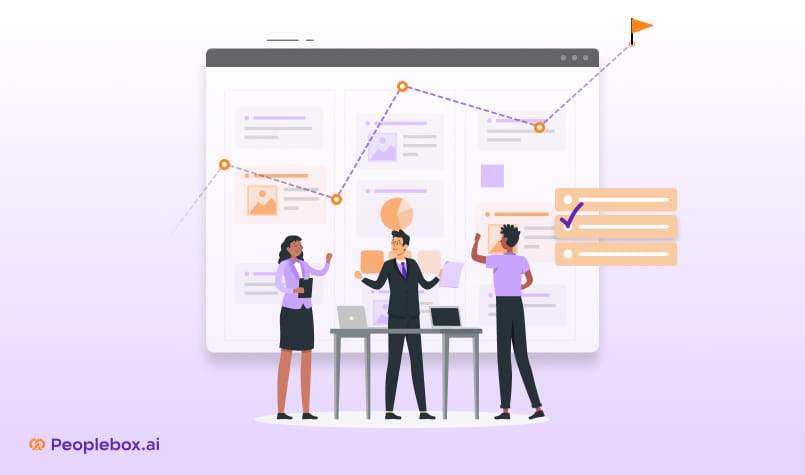If you need the latest 2025 talent and HR statistics to back your presentation to the C-suite on your new employee initiatives, you’ve reached the right place. We have scouted research papers, and talent studies, spoken to HR heads, and gathered a round-up of HR statistics, trends, and data that you can readily use and benefit from.
Hiring Related HR Statistics
The global economy is still facing a talent crisis, and one of the most excruciating issues companies are battling with is hiring the right people with future-ready skills, so they can hit the ground running and don’t need the company to spend a fortune on preparing them for the role they’re hired for.
This boils down to sharpening hiring processes to hone in on skilled individuals, fine-tuning assessments, and gathering time and cost-efficient resources that yield ROI in a short while. These goals are materialized through careful budgeting, tapping into internal talent pools, elevating the right people to higher and better roles, and nurturing their overall wellbeing, so they can deliver to the best of their potential. It starts with good hiring of course.
- 54% of employees believe that it’s a good time to find a job. 52% of the workforce are watching for or actively seeking new jobs.
- AI-enabled sourcing and screening capabilities and candidate relationship management platforms have the most potential to aid recruiting operational excellence.
- 26% of CEOs rank talent shortage as the top damaging factor to business outlook.
- A talent shortage is making it more difficult to attract and retain employees. Organizations are evaluating whether shifting towards a condensed workweek will meet growing employee expectations for flexibility.
- 36% of HR leaders say they don’t have the resources to recruit top talent.
- 77% of candidates say they would accept a job without visiting a physical office.
- 63% of candidates rated a 4-day work week as the top perk.
- Skill-based hiring trends are taking root in 2025 and are expected to only strengthen in the years to come. 73% of organizations that successfully hire one or more candidates after eliminating degree requirements for certain positions.
- Companies can save up to 80% by hiring globally in places like Argentina, Mexico, or Brazil. The time zone overlap and excellent English skills make collaboration a breeze.
Talent Pool Related HR Statistics
- HR needs to expand its talent pool by considering candidates who have been skilled through alternative routes. Also, revise job descriptions that highlight benefits appealing to Zoomers.
- Senior leaders need to improve their abilities to recruit highly talented people.
- Establish talent win rooms – This trend is where HR gathers key stakeholders from different functions and collectively brainstorms new ideas to improve aspects of the holistic candidate experience.
- 24% of companies have no strategy to onboard employees who rise with internal promotions. HR needs to get more creative and create more in-depth, hyper-personalized onboarding experiences that might provide a better employee experience.
- 62% of HRs state their recruitment efforts are rather successful when they recruit from a more diverse and underutilized talent pool.
Talent Shortage and Hiring Difficulties Related HR Statistics
- Enterprises and large and medium-sized organizations are finding it harder to recruit for full-time, regular positions than small organizations. Over 3 in 4 organizations have had difficulty recruiting in the last 12 months.
- 30% of new hires leave within 90 days.
- The average cost to a company to replace a full-time employee is $52,000.
- Those who have had success in recruiting full-time positions in the past year report:
- 59% attribute their successful recruitment to a positive work culture
- 48% say it’s because they created a strong employer brand
- Some of the most utilized recruitment strategies that have worked for companies worldwide in 2025 are:
- Using social media (60% of HRs use social media for employer branding)
- Improving compensation and offering a competitive package (51% of HRs do it)
- Voluntarily including pay ranges in the job posting (45% of HRs do it)
- Simplifying the application process to make it easier to complete (37%)
Employee Engagement Related HR Statistics
Employee engagement is a part of the experience suite now. It can’t be a standalone function anymore. Employees who dislike their jobs tend to have high levels of daily stress and worry and experience elevated levels of negative emotions.
In 2025, HRs from across the globe are talking about micro experiences and bringing in the engagement element to every touch point the employee has with the company – be it a small conversation to huge role changes.
Micro experiences include how an employee feels after being onboarded, confirmed employment after probation when others in the team get promoted but not them, when they ask for leave but are denied, and how they are treated during their day off and return.
These seemingly insignificant touchpoints are extremely important to improve the employee experience and well-being as a whole. Understanding these touch points along with the lifecycle as part of the health and wellbeing strategy, helps you educate your workforce and develop appropriate interventions to support people. Here are what HR professionals facing with respect to employee engagement in 2025.
- Gallup studies report that organizations worldwide have lost $8.9 Trillion in global GDP due to low engagement.
- 41% of employees experience a lot of stress at work, which ultimately affects how engaged, productive, and happy people are at work.
- Those who work in companies with bad and outdated management practices are 60% more likely to be stressed than those with evolving management practices.
- When managers are engaged, employees are more likely to be engaged, since employees interact with their managers on a daily basis. Managers are the first point of contact and are the first people they reach out to in case of help.
- Globally, only 23% of the workforce is engaged.
- 49% of organizations have had difficulty retaining full-time regular employees in the last 12 months.
- In companies where HR practices constantly evolve according to employee, market, and economic needs, 7 in 10 managers are engaged.
When organizations increase the number of engaged employees in the organization, they improve a whole host of organizational outcomes, including profit, retention rates, and customer services.
Here are aspects of employee experience that skyrocket along with employee engagement:
- 10% increase in customer loyalty
- 17% increase in productivity
- 13% boost in production (in manufacturing industries)
- 23% spike in profitability
- 68% heartwarming change in wellbeing
- 22% improvement in organizational citizenship
- Higher shareholder returns than their competitors
For optimal engagement, HR leaders and employers should provide appropriate benefits and flexibility to support employee wellbeing, while building productive, and high-performing teams.
Organizational Culture Related HR Statistics
Companies with strong, well-defined cultures are better equipped to adapt to changes, foster innovation, and maintain a competitive edge in a time when the world is going through an unprecedented level of change at all possible turns. The integration of artificial intelligence and a cohesive culture is essential, and creating a healthy and nurturing environment ensures that employees remain connected, motivated, and aligned with the organization’s goals.
Trust in leadership, employee engagement, and overall job satisfaction are closely tied to the cultural environment, and 2025 data also shows the same.
- About 50% of employees trust their organization, and the other half need to be addressed to prevent turnover and related avalanches that lead to loss of talent.
- 41% of HR leaders say employees’ connection to culture is compromised by hybrid work environments.
- 77% of HR leaders say their employees are feeling fatigued on a day-to-day basis.
- Employee culture connectedness can increase by up to 43% when culture is diffused through work.
Organizations are going through phenomenal changes at the moment – in terms of work nature, AI, economy, market, talent crisis, etc. There are a lot of digital transformation projects happening across verticals and industries, and naturally, change fatigue is pretty common among employees. If these change initiatives fail, they take a massive hit on morale, trust, and job satisfaction.
Employees who experience change fatigue report the following:
- 42% less likely to stay with the organization
- 30% trust the organization less
- 27% experience productivity anxiety (less sustainable performance)
Studies say that the current state of essential elements that define thriving cultures are:
| Elements | Level of influence |
| Employee sense of purpose | 73% |
| Employee sense of opportunity | 68% |
| Employee sense of success | 69% |
| Employee sense of appreciation | 65% |
| Employee sense of wellbeing | 56% |
| Employee sense of leadership | 65% |
Evolving Role of Managers in the Workplace
1/4th of leaders feel burnt out often. Simply bringing in wellbeing apps or standalone stress management training doesn’t do justice to the pressure managers and leaders feel. Time and time again, Gallup studies have found that when managers are engaged, employees are engaged too.
42% of employees who left their jobs in the previous year said that their manager or organization could have done something to prevent them from leaving their jobs. Middle managers are being sandwiched between employees and leaders and their role is constantly expanding. HR professionals and managers feel the same, and that’s what data from different surveys reveal.
- HR is starting to place more emphasis on hiring and developing managers, and on training managers into coaches.
- Employee conflict resolution is the next must-have skill for managers.
- About 50% of employees aren’t confident about their own manager’s ability to lead the team towards success in the next 2 years.
- 73% of HR leaders confirm that their organization’s leaders and managers are not equipped to lead change in the future.
Learning, Development, and Growth Related HR Statistics
Several companies are starting to shift their culture to be more development-focused, where employees tend to feel more productive, adaptable, and valuable, thereby helping with attraction and retention rates. 64% of HR leaders say developing team effectiveness in their organization is a part of their strategy to improve the future of work in 2025.
- Upskilling and reskilling are top priorities for 53% of organizations worldwide in 2025 and for the next few years.
- Organizations focused on positive habit building improve job mobility by 71%.
- Less than half (45%) of employees agree that the learning their organization provides is relevant to them.
- 89% of HR leaders believe career paths at their organizations are unclear for many employees.
- 66% of HR leaders agree career paths within their organizations are not compelling enough for many employees. Only 1 in 4 employees is confident about their career in their organization.
- Traditional career maps no longer fulfill business requirements or employee expectations and leave employees unsure of how to move forward in their areas of work and interest.
- Designing adaptive career paths that align with business needs with employees’ larger goals, interests and skills is a core responsibility of HR.
- Allow Gen Z to decide the skills and areas of expertise they desire and give them tools to keep them engaged.
Future of Work
- 1 in 4 organizations report that full-time regular positions they have hired for in the last 12 months have required new skills.
Personalized Growth Trends
- Most effective organizations encourage personalized, adaptive learning. HR and managers need to give frequent feedback and coaching, followed by peer learning opportunities, and create a digital ecosystem that helps employees track progress over time.
- Only 34% of organizations offer mentorship programs. And in those who offer mentorship, 4 in 5 organizations say they are effective in addressing talent shortages.
- 63% of organizations plan to support formal or informal mentoring programs in 2025.
Performance Management Related HR Statistics
Offering regular, collaborative, and empathetic feedback about their performance can retain employees and enforce a system of rewards that can lead to better employee morale. Trends and data show the same.
- Nearly 50% of employees have productivity anxiety and view their current performance as unsustainable.
- The annual cost to companies worldwide, for 1 hour of unproductive labor per week per employee is $15,000.
- Individuals who are top performers in highly critical roles deliver 800% more productivity than the average performers in the same role.
- Revenue per employee and difference in productivity arise in the organization because of 3 reasons.
| Skill gap | Will gap | Time gap |
| Employees don’t have the skills needed to be successful in a role. | Employees aren’t engaged or energized by the work they do. | Employees spend time in ways that don’t increase value (poor prioritization, and attending low-value meetings) |
Employee Wellbeing Related HR Statistics
Employee mental wellbeing has, until recently, escaped the return-on-investment radar, because it’s seen as a good-to-have employee benefit. Leaders are cutting down spending to maximize profits, stay afloat, and grow in the current volatile economy.
For HR, this means slower hiring, the need to keep turnover low, and preserve talent investment. This translates into HR’s goal of ensuring each employee performs at their highest potential and stays with the company for a long time. Investing in wellbeing to boost engagement is the top opportunity for HR teams.
- Globally, wellbeing declined in 2023 from 35% to 34% thus presenting a further challenge to the HR department.
- Only 32% of HR and total rewards leaders believe their organization does a good job assessing the effectiveness of their investment in wellbeing programs.
- 20% of the world’s employees are lonely, and this is staggeringly high for fully remote employees. Employee wellbeing and engagement are at the heart of improving overall life experiences for the workforce.
- 34% of the global workforce is thriving, while 58% are struggling, and 8% are suffering.
There’s no proper guidance or training for line managers on how to support people to stay at work and support them as they manage health conditions. HR professionals all over the world are working on creating workplace champions, so managers are able to pick up non-verbal distress cues and help employees as and when needed.
HR professionals also need to bring in an understanding of employee lifecycle health issues as part of their health and wellbeing strategy, so you can educate your workforce and develop appropriate interventions to support people.
HR Wellbeing Related Statistics
According to a Forbes study, nearly 98% of HR professionals worldwide are on the brink of burnout. While the world has moved beyond the pandemic, its aftermath has left HR professionals struggling to find effective solutions for the evolving workforce, technological advancements, and new workspace dynamics.
The ongoing silent mental health crisis, the Great Resignation, economic downturns, and the disruptive influence of generative AI represent significant changes occurring simultaneously, all demanding strategic management. Consequently, three years after the pandemic, the HR community remains as stressed, if not more so, than ever before.
- About 78% of HR professionals surveyed by SHRM report that their senior leaders rely on them to navigate new situations or practices.
- 77% of HR professionals would recommend their organization to others as a great place to work, compared to 53% of other employees.
- 57% of HR professionals report working beyond normal working capacity, because of increasing turnover in the organization.
- 58% say the greatest barrier to achieving their department’s priorities is a lack of time and personnel.
HR Technology Trends
Studies done by ISG confirm that organizations find it hard to derive value from HR tech implementations because they haven’t redesigned their business processes and end-to-end delivery of HR services jointly with HR technology deployments. Almost 46% of businesses have achieved measurable business value by adopting the right HR technology.
- 46% of HR leaders report HR technology is the top priority. The yearly spending on HR administration increased from $155/employee in 2021 to $194/employee in 2022.
- Only 22% of HR leaders are highly engaged in enterprise-wide discussions on Generative AI.
- 60% of HR leaders are uncertain about the impact of evolving technological trends such as GenAI.
- 56% of HR leaders confirmed their HR technological solutions and strategy do not match the current and future business needs.
Timely intervention and thoughtful planning for a one-time digital transformation is one of the things HR has on top of its priority list, and that has the capacity to reap phenomenal cost savings, results, and operational efficiency instantly.
HR Functions Using AI
| Function | % of HR professionals who use |
| Talent acquisition | 42% |
| Employee training and development | 36% |
| People analytics | 21% |
| Leadership development | 16% |
| New employee orientation | 16% |
| Organizational culture change | 15% |
| IE&D | 9% |
| Employee Listening | 6% |
- Skil management solutions, learning experience platforms with AI-enabled self-service learning options, coaching applications, and virtual reality technologies take root in 2025.
- GenAI will have an increasingly important role to play in talent attraction. Gen AI helps managers write better job requirements and match candidates with skill pools.
- AI-driven analytics help with personalized content, candidate engagement, and onboarding.
Wrapping Up
If you’re looking for an expert-backed performance and engagement management tool to help you get ahead of the above trends, reap results consistently, and give you the space to experiment freely, contact Peoplebox today.
We’ve been trusted by leading SaaS companies like RazorPay, and Nova Benefits to streamline their HR processes to meet evolving trends, leverage technology to boost your employer brand, skyrocket your employee value proposition, and make the whole process a cakewalk, for an affordable price at lighting speeds.
Want to create the same for your organization? Sign up for a free product tour and demo today!







